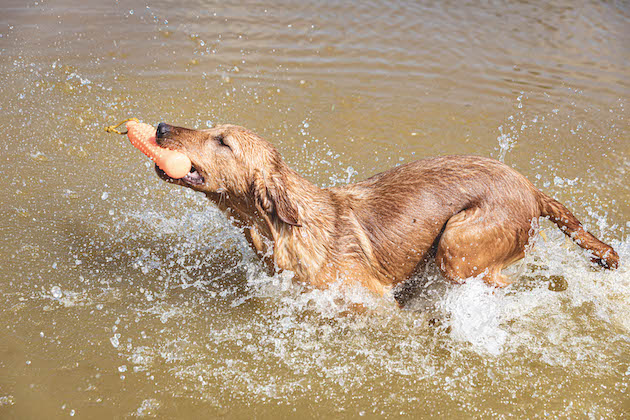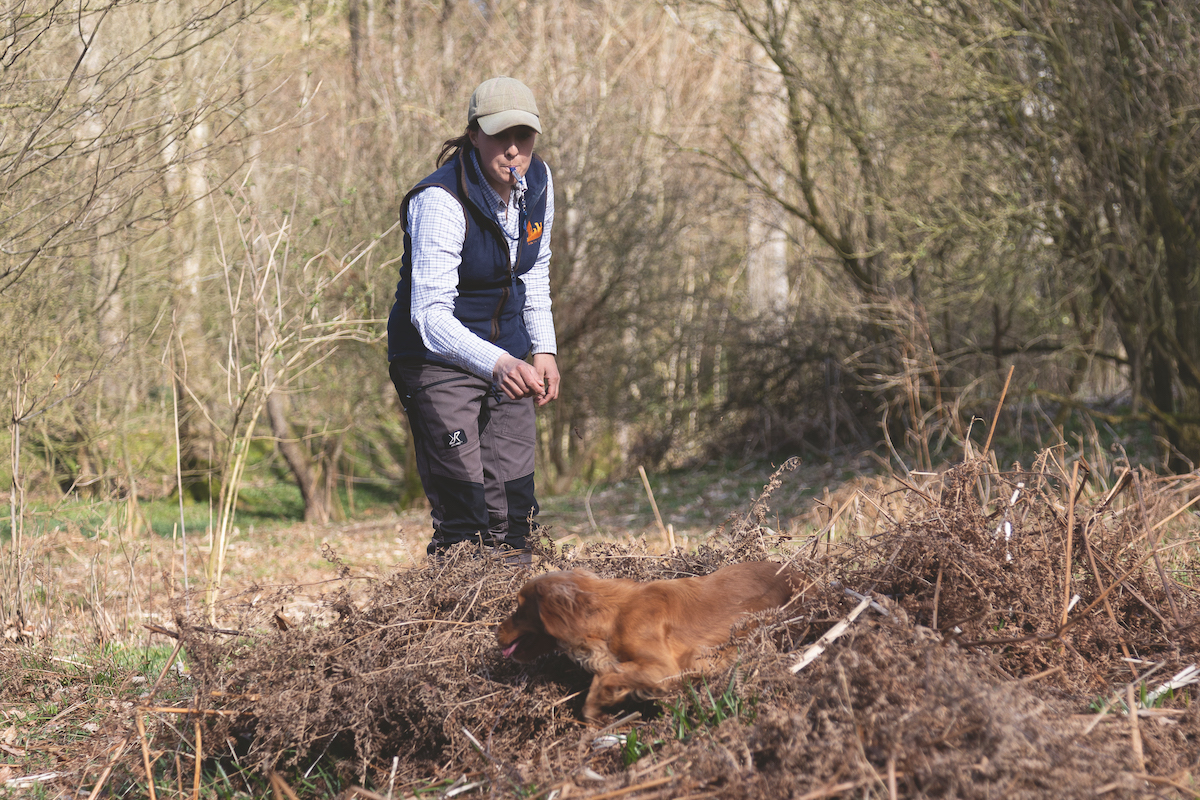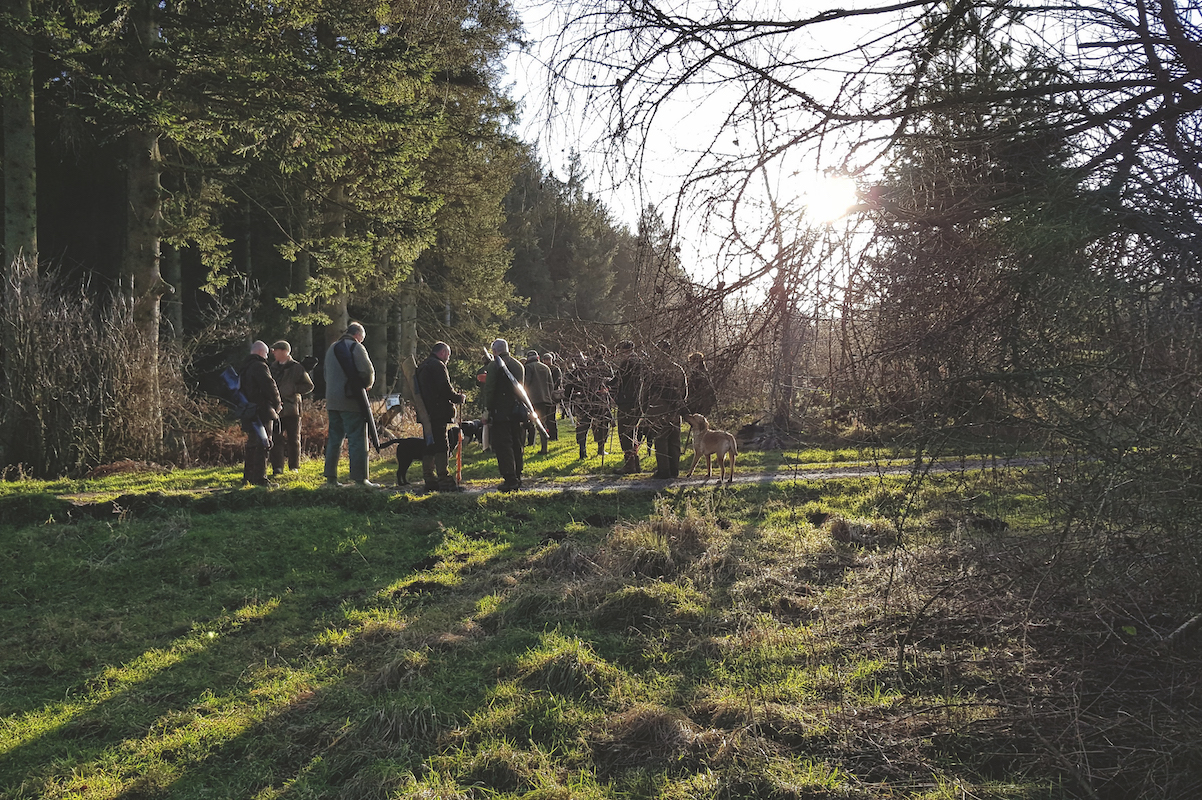Can a working gundog also be a family pet?
Will keeping a gundog in the house ruin it?

Eight month old River - appropriately named - is already used to being in water
When do pets stop being pets and become working dogs?
Can you have working dogs as family pets? I’ve talked to people whose dog is out in the field just once or twice during the season who say that their dog is only a pet. (Often an excuse for the lack of training or children are blamed for ruining any training that might have been done.)
But how much should a dog work to be classed as a working dog? How many times during the season? If anybody saw my dogs in their home environment, they would find them on the sofa, playing with my toddler and asleep on my bed when my husband is away. However they work 50 or more days a season. So are they pets or working dogs? (You might like to read our guide to the best washable gundog beds.)
So I got in touch with different working dog owners and asked the question. Some people said that if a dog is kept in the home it is a pet, and if it is kept outside in a kennel it is a working dog. I understand the angle, as some dogs that are kept in kennels outside only ever really come out to work. However, does this make them any less a pet if the family has children who often play with the dog? Or if the owner enjoys walks with the dog when not working? (Read how to keep your dog warm in kennels in winter.)

One of Ellena’s dogs
Working dogs as family pets
During my first season field trialling I learned a lot watching fellow handlers. One friend and competitor was thrilled to make up his labrador to a field trial champion and qualify for the International Gundog League championships. This dog is quite clearly worth a great deal in both monetary and sentimental value and could easily be viewed as an asset rather than a pet. His potential earnings as a fully health-tested field trial champion are unlimited and I am sure he will do well as a stud dog. So it was interesting to hear how the dog spent its evenings curled up either in front of the fire or on the sofa. It was even more amusing to discover that said dog could be found sneaking into the couple’s bed when he felt like a cuddle. It was clear that this was a loved and valued pet as much as it was a competition dog. (Read more about field trials and dogs here.)
We see many working dogs given specific jobs: in the police force, security, search and rescue, as guide dogs and even as cancer detection dogs. The list of roles our canine friends fill is vast and it is clear that no animal nor human could come close to replacing them. These dogs spend the best years of their lives in these working roles. They are true working dogs.

Ellena Swift with her dogs
Assistance dogs
However, if you visit the home of an assistance dog, you will find that while the dog quite clearly works for his living, he is also a comfort, a companion and, more importantly, a friend to the person he is assisting.
If you suggested to the handler that the dog was a working dog and therefore only a commodity they would take justified offence. So why are the dogs working in roles in the countryside any different?
https://www.instagram.com/p/CauuhJVJGby/?utm_source=ig_web_copy_link
Throughout my research into this, I did come across a very small handful of dogs that rarely came out unless they were working. They had little interaction with the owners unless out doing their job and the owners seemed less connected, perhaps, than the majority I spoke to. However, these types of relationships between dog and owner were so few and far between that I could count them on one hand. If they are the true “working dog” it would appear we have a country full of working pets. I don’t mind my dogs being labelled as pet or working animals, as they fulfil both roles wonderfully and I am proud of them.

Should a working cocker puppy be housed in a kennel?
Should I keep my dog in a kennel or inside the house?
Q: We are getting our first working cocker puppy soon and have two children, aged three and five. I intend to train the dog for beating, but have had some negative advice from shooting friends who claim the dog will be ruined in the family house.
Is it difficult to rear a young working spaniel puppy in the house? I am not keen on having it outside in a kennel.
A: (Jeremy Hunt replies) There are many pros and cons for both ways of rearing a puppy, so the answer to your question is not simple. A well-socialised puppy is much easier to train than one that has lived in isolation.
However, there is no reason why, with the correct management, a puppy living in kennels cannot be properly socialised.
Equally, gundogs being reared in the house with a young family should have its own living space to avoid its being pestered continually by overenthusiastic children. A separate room — perhaps a utility room or office — containing the puppy’s bed, water, food and toys to make it feel at home is essential, or a large indoor kennel where it can seek refuge if needed. This can also be used to put the dog out of the way during family meal times. (Read Ellena’s tips on crate training a puppy.)
An outside kennel could be used in the same way as a separate room, but the puppy must have plenty of interaction with you; it must not be left in isolation for hours on end, as this could seriously affect its well-being and mental development. Puppies reared without sufficient human contact can become withdrawn, nervy, bark incessantly or just chew everything to relieve boredom.
All puppies need mental stimulation, good nutrition and the correct amount of exercise and training in order to develop into sound, sociable, obedient adults.
This article was originally published in 2014 and has been updated.








